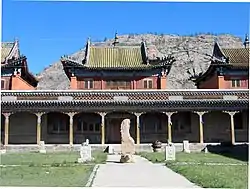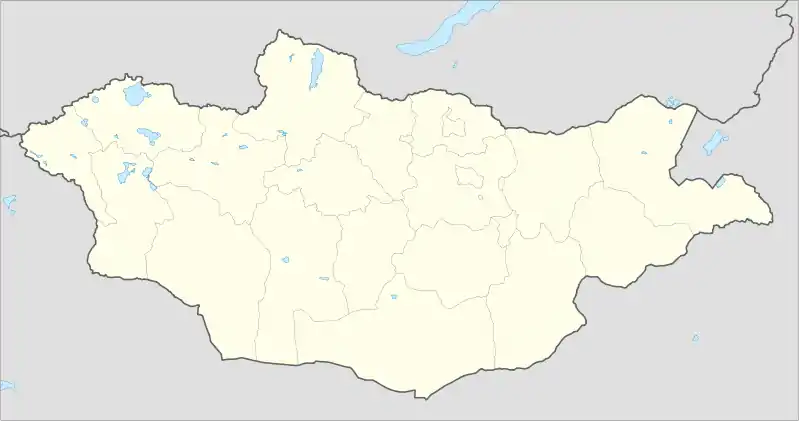Tsetserleg (city)
Tsetserleg /ˈtsɛtsərlɛɡ/, also romanized as Cecerleg (Mongolian: Цэцэрлэг, pronounced [ˈt͡sit͡sɪrɮɪk]; lit. "park" or "garden") is the capital of Arkhangai Aimag (province) in Mongolia. It lies on the northeastern slopes of the Khangai Mountains, 600 kilometres (370 miles) southwest of Ulaanbaatar. It has a population of 16,553 (2000 census, with Erdenebulgan sum rural territories population was 18,519), 16,618 (2003 est.), 16,300 (2006 est.).[1]
Tsetserleg
Цэцэрлэг ᠴᠡᠴᠡᠷᠯᠢᠭ | |
|---|---|
| Erdenebulgan District Эрдэнэбулган сум ᠡᠷᠳᠡᠨᠢᠪᠤᠯᠠᠭᠠᠨᠰᠤᠮᠤ | |
 Zayiin Gegeen Monastery | |
 Tsetserleg | |
| Coordinates: 47°28′37″N 101°27′01″E | |
| Country | Mongolia |
| Province | Arkhangai Province |
| Founded | ~1631 |
| Area | |
| • Total | 536 km2 (207 sq mi) |
| Elevation | 1,691 m (5,548 ft) |
| Population (2017) | |
| • Total | 21,620 |
| • Density | 40/km2 (100/sq mi) |
| Time zone | UTC+8 (UTC + 8) |
| Area code | +976 (0)133 |
| Vehicle registration | АР_ ( _ variable) |
| Website | http://erdenebulgan.ar.gov.mn/ |
Tsetserleg is geographically located in the Bulgan sum in the south of the aimag. It is not to be confused with Tsetserleg sum in the north. In 1992 Tsetserleg was designated as Erdenebulgan sum, which has an area of 536 km2 (207 sq mi).
History

Tsetserleg is an ancient cultural and commercial centre. It was once the seat of a monastery (Zayiin Gegeen Monastery),[2][3] built by the First Khalkh Zaya Pandita, Luvsanperenlei (1642–1715) (who should not be confused with Zaya Pandita Namkhaijantsan (1599–1662)). It consisted of the main Guden Süm, the Right, or Summer Semchin Temple, and the Left, or Winter Semchin Temple, all built in the early 1680s. The sixth Zaya Pandita, Jambatseren, was killed by the Communists in 1932, and the main Guden temple was turned into a museum. There is a seventh Zaya Pandita, but he mostly lives in Ulan Bator and visits only occasionally.
Facilities
Tsetserleg has an airport, with regular connections from and to Ulan Bator, a theatre, hotel, hospital, and an agricultural college. The main industry is food processing.

Famous people
- Bat-Erdenyn Batbayar (Baabar), historian
- Radnaasümbereliin Gonchigdorj
- Gelegjamtsyn Ösökhbayar, wrestler
- Maidarjavyn Ganzorig, cosmonaut and scientist
Climate
Tsetserleg has a dry-winter subarctic climate (Dwc). It is part of a microclimate which experiences cooler summers and warmer winters than the rest of Mongolia. Wind speed is also relatively calm on average. In the coldest month of winter, January, it is often the warmest place in the country and temperatures rarely plummet below -30 °C, often hovering at around -15 °C to -25 °C during nighttime and 5 °C to -15 °C during daytime. In January 2014 and 2015 the coldest temperature was -26 °C (each during a short cold snap) while average minimum temperature was -16 °C which was 12 degrees warmer than the Ulaanbaatar average minimum of -28.5 °C (January 2014 and 2015) and identical to the Hohhot average minimum of -16 °C (January 2014 and 2015).[4] The average maximum temperature in January 2015 was 0 °C or the same as Hohhot while overall average January temperature was -9 °C again the same as Hohhot. The warmest temperature of the 10 days above 0 °C in January 2015 was 7 °C which was warmer than Hohhot in which the warmest of the 8 days above 0 °C in January 2015 was 6 °C. Dalanzadgad and Arvaikheer, two other 'mild' cities of Mongolia, experienced identical temperatures although average minimum was marginally warmer at -15 °C each while Dalanzadgad's warmest January day was marginally warmer at 8 °C. Tsetserleg belongs to USDA Plant Hardiness Zone 5.[5][6]
| Climate data for Tsetserleg (1991-2020 normals, extremes 1937-present) | |||||||||||||
|---|---|---|---|---|---|---|---|---|---|---|---|---|---|
| Month | Jan | Feb | Mar | Apr | May | Jun | Jul | Aug | Sep | Oct | Nov | Dec | Year |
| Record high °C (°F) | 9.5 (49.1) |
12.5 (54.5) |
18.2 (64.8) |
28.4 (83.1) |
29.9 (85.8) |
33.3 (91.9) |
34.8 (94.6) |
34.0 (93.2) |
29.8 (85.6) |
23.9 (75.0) |
16.0 (60.8) |
11.1 (52.0) |
34.8 (94.6) |
| Average high °C (°F) | −8.4 (16.9) |
−4.8 (23.4) |
1.9 (35.4) |
10.3 (50.5) |
16.4 (61.5) |
21.2 (70.2) |
22.7 (72.9) |
21.1 (70.0) |
16.2 (61.2) |
8.1 (46.6) |
−0.3 (31.5) |
−6.4 (20.5) |
8.2 (46.7) |
| Daily mean °C (°F) | −15.1 (4.8) |
−11.9 (10.6) |
−5.0 (23.0) |
3.3 (37.9) |
9.3 (48.7) |
14.4 (57.9) |
16.3 (61.3) |
14.4 (57.9) |
8.8 (47.8) |
1.3 (34.3) |
−6.9 (19.6) |
−12.7 (9.1) |
1.3 (34.4) |
| Average low °C (°F) | −20.1 (−4.2) |
−17.6 (0.3) |
−11.2 (11.8) |
−2.9 (26.8) |
2.6 (36.7) |
7.9 (46.2) |
10.5 (50.9) |
8.6 (47.5) |
2.5 (36.5) |
−4.3 (24.3) |
−13.1 (8.4) |
−17.5 (0.5) |
−4.5 (23.8) |
| Record low °C (°F) | −36.1 (−33.0) |
−33.9 (−29.0) |
−31 (−24) |
−21.1 (−6.0) |
−12.0 (10.4) |
−4.0 (24.8) |
−4.0 (24.8) |
−2.2 (28.0) |
−9.6 (14.7) |
−22.6 (−8.7) |
−28.5 (−19.3) |
−35 (−31) |
−36.1 (−33.0) |
| Average precipitation mm (inches) | 1.9 (0.07) |
2.7 (0.11) |
5.8 (0.23) |
16.3 (0.64) |
32.6 (1.28) |
63.1 (2.48) |
75.4 (2.97) |
66.9 (2.63) |
26.7 (1.05) |
13.4 (0.53) |
5.8 (0.23) |
2.6 (0.10) |
313.2 (12.32) |
| Average precipitation days (≥ 1.0 mm) | 0.7 | 0.9 | 2.0 | 4.3 | 5.8 | 9.9 | 13.5 | 11.8 | 5.0 | 3.3 | 1.9 | 1.1 | 60.2 |
| Mean monthly sunshine hours | 185.7 | 197.2 | 250.2 | 245.6 | 279.6 | 275.4 | 265.2 | 260.5 | 254.0 | 232.5 | 186.6 | 172.6 | 2,805.1 |
| Source 1: Pogoda.ru.net (temperature)[7] | |||||||||||||
| Source 2: NOAA (1961-1990), [8] Meteo Climat (record highs and lows)[9] | |||||||||||||
Sister cities
| City | State / Region | Country | Year | Sources |
|---|---|---|---|---|
| Bellingham | 2011 | [10][11] |
References
- Rural Poverty Reduction Programme
- Zayiin Gegeen Monastery
- Zayiin Gegeen Monastery in Arkhangai Province
- # Jan 2015 Climate History for Tsetserleg, Mongolia. Weather Underground.
- Arkhangai Meteorological Department.
- # Climate History for Tsetserleg, Mongolia. Weather Underground.
- КЛИМАТ УЛАН-БАТОРА (in Russian). Pogoda.ru.net. Retrieved 4 January 2015.
- "Tsetserleg Climate Normals 1961-1990". National Oceanic and Atmospheric Administration. Retrieved January 13, 2013.
- "Station Tsetserleg" (in French). Meteo Climat. Retrieved 10 July 2023.
- "Our Sister Cities". Bellingham Sister Cities Association. Retrieved 20 January 2015.
- "Interactive City Directory". Sister Cities International. Archived from the original on 21 January 2015. Retrieved 20 January 2015.
- Don Croner's World Wide Wanders: Tsetserleg
- "Tsetserleg" Encyclopædia Britannica
- Mongolia City Development Strategies for Secondary Cities
